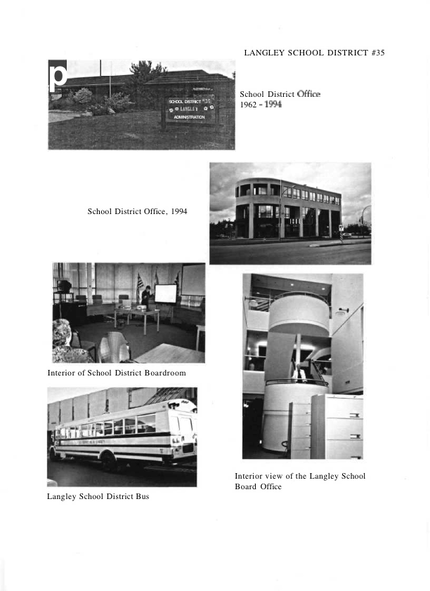Before Confederation with Canada in 1871, a Free School Act (1865) was passed in BC but applied only to Vancouver Island. In 1867 the Common School Ordinance was written which applied to the recently-united colonies of BC and Vancouver Island. This ordinance subsidized schools to the extent of $500 per school per year. The rest of the cost of education was shouldered by the local school boards which were limited in setting tuition fees to $2 per month. Following Confederation, a new Public School Act was passed in 1872, and a BC superintendent of schools was appointed. At that time there were approximately 40 children in the Langley district, and each individual school had its own Board of School Trustees.
In the early days, the school boards could neither set a teacher’s salary nor dismiss him/her. The teachers earned from $40 to $100 per month depending on the number of pupils and attendance in their one-room schools. They taught all subjects including spelling, grammar, geography, arithmetic, history, algebra, and bookkeeping to ungraded classes, usually grades 1 – 8 in one room. Compulsion to attend school was introduced after 1873, but many boards had difficulty enforcing the rule.
In 1906-7 the Langley School District was formed with Boards of Trustees for 15 individual public schools amalgamated under one board. Existing schools were Belmont, Aldergrove, Glen Valley, South Aldergrove (Patricia), Langley Prairie, Port Kells, Lochiel, Beaver, Langley, Otter, Springbrook, Glencoe, Douglas, East Langley, and Glen wood.
The first high school class was created in 1909, using Billy Murray’s Hotel, with Angus McDonald earning $80 to teach 23 grade 9 and 10 students. Two months later, the high school moved to the Old Cheese Factory in 1909, and then to Belmont Superior School in 1911. Later it was moved to Milner, then in 1924 to Langley High School on Fraser Highway, and finally, in 1948-9, to Langley High School on 56 Avenue.
The Langley School Board’s first permanent location in 1912 was in the Langley Municipal building, opposite Murrayville School. In 1962-3 a new school board building was constructed at 22249-48 Avenue which served as the administrative centre until the new centre opened in August, 1994.
Many controversial events have occurred in Langley over the years. In 1920 the Board decided against borrowing money for a new school, thus forcing shifts at Murrayville and Langley Prairie schools. Much controversy occurred in the 1930s over traditional (e.g. Latin, history) versus “modern” educational courses (e.g. home economics and manual training). In the late 1930s teachers’ demands for salary increases, retroactive eight years, resulted in an arbitration board hearing and the dismissal of the school board in 1940. Frank Calvert was the official trustee from 1940-46. Complaints from students about poor conditions and shifts during the 1940s finally forced the Board to build Langley High School on 56 Avenue in 1948. In the 1950s the municipal council threatened to resign over the mounting costs of education (average salary of teachers was $2,576 per year). More shifts occurred in 1955, followed by the building of Aldergrove Secondary in 1958. Other shifts followed at Langley High School before D. W. Poppy and Brookswood were built. Changes in rules and policies also occurred over the years. In September, 1931, the high school curriculum in BC extended to four years from three. Under the new grading system in 1936, merit and demerits were issued for personal appearance and cleanliness. School patrols were initiated in 1952, and grants were cut off for bus students being transported less than three miles. Mrs. A. Medd became the first woman chair of the Langley School Board in 1955. TV equipment was rented in 1963 for use at Aldergrove High School on a trial basis. In 1966 the first kindergarten was introduced at West Langley Elementary. In 1967 the County Line PTA discussed the introduction of sex education into schools. In 1969 seven local school districts voted for the formation of Douglas College. Adult education increased in enrolment in Langley, and the first fundamental elementary school was opened in 1975 at Langley Central. Much controversy between the teachers/community and the “Back to Basics” School Board resulted in many resignations and a lowering of morale among teachers and administrators in the late 1970s. Computer report cards were introduced at all seven secondary schools in 1979. Decentralization became the theme for decision-making and financing in 1983. In 1987 the first non-graded secondary school (Langley Education Centre) was initiated. The number of international students, paying $6,500 per year ($12,500 in 2004), increased in Langley schools in the 1990s.
In 2004 the total number of teachers in Langley was 1149, and the total number of students was 20,339 which includes 8156 secondary students, 11,061 elementary students, and 450 international students, There are nine secondary schools, and 35 elementary schools, plus several alternative schools/programs [LEC, LEC U-Connect, PASS (216), Uplands and Mountain hearing programs (26), and home schooled students (14), and Apex].
Many support staff are necessary to run a modern school system. In Langley School District, there are 80 maintenance workers, 430 support staff (custodians, noon supervisors, secretaries, teacher assistants, cross walk supervisors, child care workers, etc.), 86 school board personnel, 95 administrators, 36 special services personnel, plus many bus drivers and school busses.
Superintendents
- H.D. Stafford 1959-1969 Provincial Inspector of Schools in the 1950s, then Superintendent 1959-1969
- Charles Cuthbert 1969-1979
- Len Sampson 1979-1982
- Emory Dosdall 1982-1994
- Susan Everett 1994-1995
- Richard Bulpitt 1996 – 2001
- Don Truscott 2001- 2006
- Cheryle Beaumont 2006-2012
- Suzanne Hoffmann 2012 – 2016
- Gord Stewart – 2016 (present)

